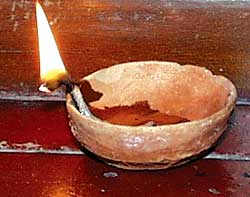 What are left of our traditions are becoming hollow rituals of an ersatz civilisation. The original function of harvest festivals, the celebration of plenty and family bonding have given way to trivial give-and-take of the marketplace. Dasain and Tihar in the city have become little more than government-sanctioned bandas. There is a curfew for bhailo and deusi, and defying a firecracker ban the Maoists blew up the first floor of the Sanchaya Kosh Building on Tuesday. Aside from the bubble of the capital valley and a few cities, the festivals have lost their lustre. The people are in no mood to celebrate.
What are left of our traditions are becoming hollow rituals of an ersatz civilisation. The original function of harvest festivals, the celebration of plenty and family bonding have given way to trivial give-and-take of the marketplace. Dasain and Tihar in the city have become little more than government-sanctioned bandas. There is a curfew for bhailo and deusi, and defying a firecracker ban the Maoists blew up the first floor of the Sanchaya Kosh Building on Tuesday. Aside from the bubble of the capital valley and a few cities, the festivals have lost their lustre. The people are in no mood to celebrate. Still, Tihar is also a celebration of sibling reunion. A chance for sisters and brothers scattered by conflict to get together at least in their hearts. And an opportunity this weekend to look beyond the family to all Nepalis as our own sisters and brothers.
It is in these times of murky gloom that we inevitably take comfort in symbolism: the terracotta cup in which we pour mustard oil, dip the wick and light a lamp. It will burn all week of the Yamapanchak. The number five is a recurrent theme over Tihar/Chhat/Diwali. The diyo encorporates the panchatatwa, the five elements of life: earth, water, air, fire and sky. The flame is a miniature sun, the star to which we owe the existence of life on this planet and every molecule in our being.
The potter shapes this cup from a mixture of water and earth, lets it dry in the sun, then bakes it in fire. The diyo in the puja room is a symbol of life, death and rebirth, of eternity and immortality. It leads us from darkness to light. And the darker the night, the brighter the light.


